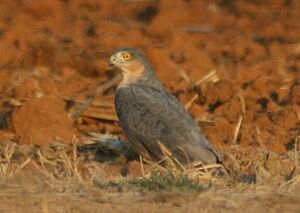Rufous-breasted sparrowhawk facts for kids
Quick facts for kids Rufous-breasted sparrowhawk |
|
|---|---|
 |
|
| Just after it had caught something in the late afternoon, Cedara Farm, Pietermaritzburg, KwaZulu-Natal, South Africa. | |
| Conservation status | |
| Scientific classification | |
| Genus: |
Accipiter
|
| Species: |
rufiventris
|
| Subspecies | |
|
|
The rufous-breasted sparrowhawk (Accipiter rufiventris) is a cool bird of prey. It's also known as the rufous-chested sparrowhawk or red-breasted sparrowhawk. This amazing bird belongs to the Accipitridae family, which includes many hawks and eagles.
You can find this sparrowhawk in many countries in Africa. These include Angola, Democratic Republic of the Congo, Eritrea, Eswatini, Ethiopia, Kenya, Lesotho, Malawi, Mozambique, Rwanda, South Africa, South Sudan, Tanzania, Uganda, Zambia, and Zimbabwe.
Contents
What Does It Look Like?
This sparrowhawk is a small bird of prey. It stands about 30 centimeters (12 inches) tall. Its wings can spread up to 72 centimeters (28 inches) wide.
It gets its name from its special reddish-brown belly. This color is called "rufous." You can see this color when the bird is sitting or flying. Its back and head are a dark grey-brown color. It has a black beak and bright yellow eyes.
When it flies, you can clearly see bold stripes on its wings and tail. Young sparrowhawks might have more white on their undersides. But they all have dark streaks on their belly feathers. You can tell it apart from the Ovambo sparrowhawk because it doesn't have a dark patch behind its eyes. It also doesn't have a white "eyebrow."
Bird Family Tree
The rufous-breasted sparrowhawk is part of the Accipitridae family. This family includes many birds of prey. It belongs to the Accipiter group. This group has sparrowhawks, goshawks, and other small hawks that live in forests.
It is very similar to the Eurasian sparrowhawk. Some scientists think they might even be the same species!
Where It Lives
This sparrowhawk lives in specific forest areas. It prefers mountain forests. You can find it from the Cape of Good Hope all the way to the Ethiopian Highlands.
Its home range is quite small. It lives in separate patches of forest. But it has started to spread to new areas. This happened because new pine trees were planted there.
How It Behaves
We don't know much about what this sparrowhawk eats. We also don't know much about how its babies grow. But it acts a lot like other sparrowhawks from Africa and Europe.
What Sounds Does It Make?
Its call is a series of quick, high-pitched "kew" sounds. The male bird makes a higher sound than the female.
When the female wants food, she makes a longer "kieee-u" sound. She uses this to ask the male for food. Young birds also use this sound. They use it to beg for food when adult birds are nearby.
What Does It Eat?
This sparrowhawk usually hunts while flying. It often catches doves and other small birds. Sometimes, it will hunt from a perch. From there, it might catch insects or small mammals. This can even include bats! It also eats reptiles sometimes.
Reproduction and Life Cycle
During courtship, the male flies very high above the nest. He calls out to the female. They often mate after the male brings the female some food.
Their nests are like platforms made of small sticks. They build these nests 6 to 18 meters (20 to 60 feet) above the ground. They break off sticks with their talons while flying. They also use their beaks to break sticks. They usually build a new nest every year. But the new nest is often very close to the old one.
The female lays two to four eggs in September and October. The eggs are white. They have reddish-brown spots that are darker at one end. The female mostly sits on the eggs to keep them warm. The male goes out to find food. He gives the food to the female in a nearby tree.


